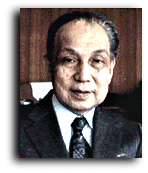|
ügThe bifizs bacteria conditions the intestinal environment and prevents infection üh
ü@
Dr. Tomotari Mitsuoka
The word "immunity" has been recognized as a key concept since the case of O-157 two years ago, and is closely linked with the intestinal environment. Dr. Tomotari Mitsuoka, among the leaders in research into coliform bacteria, advocates "increasing the body's own protection by making the intestines more hospitable to Lactobacillus bifidus." We asked him about the part of oligosaccharide that is regarded as the most necessity for the moderns in order to increase "immunity." ü\ü\Please tell us about the circumstances that oligosaccharide was exploited. MitsuokaüF About 14 or 15 years ago, someone from Meiji Seika brought me oligosaccharide exploited as sugar without carious teeth, asking me to consider it as a sweetener. At that time, I thought it could be used as food for Lactobacillus bifidus inside intestines. In fact, as seen both in-vivo and in vitro, it increased Lactobacillus bifidus populations. Given oligosaccharide, we discovered that people with both normal or low Lactobacillus bifidus counts increased their Lactobacillus bifidus. This was my first experienced with oligosaccharide. Through such circumstances, oligosaccharide has been marketed as a sugar for increasing Lactobacillus bifidus, rather than as a non-tooth-decay promoting sweetener. Emulsified Lactobacillus bifidus made by Ensuiko-Seito and Calpis's soybean-oligosaccharide gathered much attention. ü\ü\Early evidence that oligosaccharide increases Lactobacillus bifidus Mitsuoka: In 1900, Tissier in France first found "Lactobacillus bifidus " in the fecal matter of infants fed mother's milk. The infants had Lactobacillus bifidus colonies that occupied more than 95% of their intestines, and were healthier, without diarrhea, compared to bottle-fed infants with low Lactobacillus bifidus counts, who were susceptible to diarrhea. This period saw much research concerning material that increased Lactobacillus bifidus in infant intestines, or the bifidus factor as it was called, and a number of factors such as bifidus factorćTandćU were found. However, all these factors differed, and failed to match. Discovered by Petuely in Austria, lactulose composed of lactose is one of these bifidus factors. Research into bifidus factors has since been conducted to find out how to increase infant Lactobacillus bifidus counts. However, the oligosaccharide made available by Meiji was seen as a product for increasing Lactobacillus bifidus in adults, rather than infants. They discovered that Lactobacillus bifidus existed in adult as well as infant intestines, forming a valuable component of health maintenance. However, it also proved extremely difficult to improve Lactobacillus bifidus populations. Some improvement, or increase in good bacterium counts after controlling both good and bad bacterium by result of a course of antibiotics. But counts would gradually return to previous levels. In the case of oligosaccharide, it was found that good improvement of intestinal bacterium plexus could be maintained. At that time, a Belgian researcher asked many questions about oligosaccharide, prompting the current European interest in oligosaccharide. Oligosaccharide is currently obtained from various materials. Many companies are producing emulsified-oligosaccharide, xylose-ologosaccharide, soybean-oligosaccharide, galactose-ologosaccharide and isomalt-oligosaccharide. ü\ü\Oligosaccharide as a functional food in future Mitsuoka: Currently, the idea of improving the intestinal bacterium plexus is more popular in Europe than in Japan, and a product resembling a lactic bacterium that activates intestinal valuable bacterium "probiotics " is available. Probiotics is a word invented by analogy to Antibiotics. However, some three years ago, Gibson in England used the word "Prebiotics "for a product such as oligosaccharide that helps increase valuable intestinal bacterium and promotes better health. The term "Prebiotics "is now in common use. In contrast, in Japan, I was met with frowns when I established a distinction between useful and harmful intestinal bacteria. They responded that it was impossible to classify intestinal bacteria according to usefulness or harmfulness, and that even a colon bacillus synthesizes vitamin. But I insisted that we could consider bacterium to be harmful if 80% acted harmfully, even if 10 or 20% appeared useful. Conversely, it is important for good health to increase useful bacteria counts, and food with this effect is called "Functional Food." In Europe, they distinguish Functional Foods between Probiotics and Prebiotics. I think that we should also add a category of "Biogenics " as a Functional Food. This refers to a physiologically-activated substance, which improves the balance of the intestinal bacterium plexus, or directly modulates an organism's function without improving the balance. Examples include an extract of lactic fermentation and Arabinoxylan. I think that Probiotics, Prebiotics, and Biogenics should all be considered to be Functional Foods. ü\ü\Finally, please tell us about a health care regimen to enhance protection. Mitsuoka: First of all, try to avoid constipation. We can tell much about our health condition from the condition of our stools. Constipated stools appear dark, indicating alkaline content and few Lactobacillus bifidus. In contrast, acid stools are yellow, with high Lactobacillus bifidus counts and relatively little odor. We can enhance health benefits by increasing Lactobacillus bifidus in our intestines, and in such efforts, oligosaccharide is significant. Strong protection greatly reduces the potential harm of o-157. In particular, children and the elderly over 70 years old with lower levels of natural protection are susceptible to O-157. It's important to promote high Lactobacillus bifidus counts through judicious use of Functional Foods. üE üE
|
|
|



